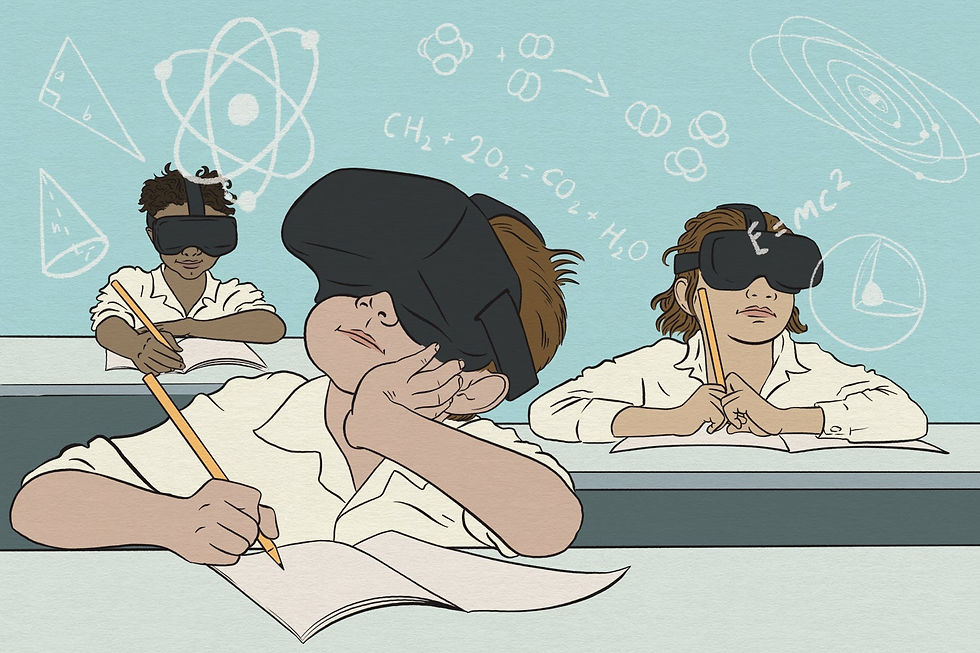Classroom Transformation in the Digital Age
- Payal Shah
- Jul 1
- 4 min read

Cliff (2025) says that the traditional classroom, with its rows of desks, chalkboards, and a teacher leading instruction, is undergoing a remarkable transformation. This is not just a local or national trend, but a global shift. Schools everywhere are integrating technology to aid creativity, collaboration, and critical thinking in students. We are preparing students for an increasingly digital world; therefore, schools are shifting to a student-centered learning environment.
Classroom Redesign
In today's classroom, rows of desks have been replaced with groups of desks or chairs that aid in collaboration. Some teachers have also adopted flex seating, where students do not have an assigned seat. Students can choose from various seating options, including bean bags, stools, a couch, and balls. Whiteboards, walls, interactive screens, and makerspaces are some of the elements that allow movement, choice, and engagement in the classroom.
Physical changes reflect a change in the teacher's mindset. They recognize that changes in the environment will encourage students to interact with content and with one another. These changes promote flexibility, exploration, and interaction among students.
Teacher-led to Student-centered
The most significant shift is seen in how the lessons are conducted. Teachers are now coaches and facilitators. They provide guide instructions and then encourage students to ask questions, promote research, solve problems, and present their findings.
Technology plays a key role in this shift. Tools like Seesaw, Google Suite, and educational apps are helping students explore their topics. Student-centered learning is fostered through project-based learning, where students engage, collaborate with their peers, and utilize technology. Students are led through inquiry-based learning by encouraging them to ask questions, explore, and discover. Students are given a choice to demonstrate their knowledge through a mode they prefer. Collaboration is encouraged and promoted to foster teamwork and communication skills. Teachers are helping students towards deeper understanding while teaching them essential skills they will need beyond their classrooms.
A balance between Digital and Hands-On Learning
Dan Schwartz asserts that technology is a game-changer for education, providing universal access to high-quality learning experiences and enabling the creation of new teaching methods (Spector, 2024). Even as schools welcome technology, they recognize that hands-on, experiential learning is essential to create a well-rounded educational experience. For example,

students receive explicit hands-on instruction in math, followed by practice of the concept using an educational app. In lower elementary, students listen to stories on an educational app and then write their responses in their notebooks. The above blended approach ensures that technology is used to enhance a lesson rather than replace explicit hands-on learning.
Supporting Diverse Learning
Millier (2025) notes that the internet has helped personalize learning and individualize experiences based on learning styles and skill sets. Teachers can now utilize data, educational apps, and adaptive technologies (speech-to-text tools, audiobooks, screen readers, or adaptive software) to personalize learning opportunities for students based on their skills, needs, and learning styles. Programs that adjust in real time to students’ performance provide immediate feedback and scaffolding needed to help engage and motivate students. This personalized approach enables students to take ownership of their learning, delve deeper into areas of interest, and receive targeted support.
Global Perspective
Since the introduction of the internet, schools and students worldwide have been able to communicate, collaborate, and share knowledge. They can learn about different cultures and their beliefs and develop an understanding of global issues. The exchange of ideas and cultural awareness helps enhance educational processes, foster tolerance of others, and prepare students to be global citizens, understanding international perspectives and engaging in cultural exchanges.
Overcoming Challenges
Breisacher (2025) notes that while the benefits of technology integration are clear in transforming classrooms, they do not come without challenges. Digital equity, budget restraints, infrastructure limitations, insufficient training, and excessive screen time are some of the common challenges faced by schools.
School districts and educational leaders are collaborating to ensure that all students, regardless of grade level or socioeconomic background, have equal access to digital tools and online resources. Districts are investing in ongoing training for educators to facilitate successful technology integration. Many districts are adopting phased approach, starting with pilot programs, collecting feedback, and then scaling gradually, says Miller (2025).
Conclusion
According to Millier (2025), the internet's profound impact on education has led to a new world of learning in the digital age. It has enhanced research, cooperation, and access to knowledge, promoting personalized learning. The internet has also facilitated cross-cultural interaction and global connections, enabling students to thrive in an increasingly interconnected world. Breisacher (2025) suggests that through ongoing professional development, collaboration, and a commitment to equity, educators can continually explore new ways to integrate technology into the classroom and create meaningful learning experiences for all students.
Breisacher, J. (2025, Feb.10). Benefits of educational technology integration in classrooms. Student-centered world. https://www.studentcenteredworld.com/classroom-technology/#the-role-of-technology-in-education
Cliff, (2025, Apr. 12), Classroom 15X: The future of modern learning space. Adore Magazine. https://www.adornmag.com/classroom-15x/
Millier, J. (2025, March 11). The internet’s impact on education: Transforming learning in the digital age. eLearning Industry. https://elearningindustry.com/the-internets-impact-on-education-transforming-learning-in-the-digital-age
Spector, C. (2024, Feb. 14). How technology is reinventing education. Stanford Report. https://news.stanford.edu/stories/2024/02/technology-in-education



Comments